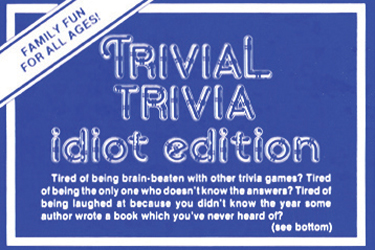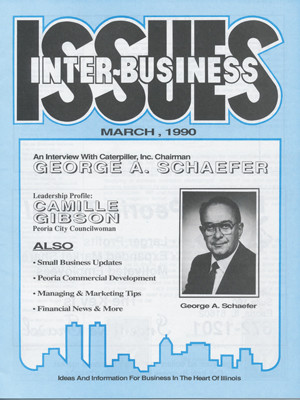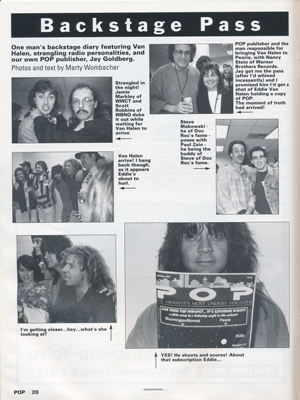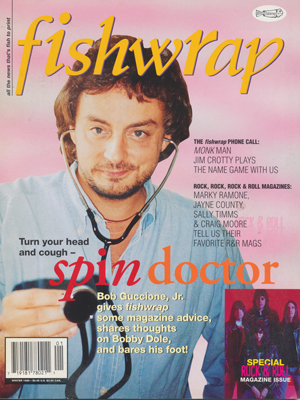“Someone once told me that you can do about anything and go about anywhere if you act like you know what you’re doing.” Marty Wombacher might have said that… but he didn’t. That was my dad, recalling his abrupt entry into the magazine business—but he might well have been talking about Peoria’s top blogger, two-time magazine publisher and proverbial “man about town.” To this, I imagine Marty would counter: “I don’t pretend to act like I know what I’m doing.” But the truth is, he does.
Three years into his never-ending homecoming tour, you’ve probably seen Marty out and about, his trusty old point-and-shoot in hand. Nearly every morning, he types up his exploits from the day before, each photo essay posted by 11am on his popular blog, Meanwhile, Back in Peoria. What readers may not know is that twenty-some years ago, Marty was doing something very similar, but in print.
Back in the early ’90s, he and my late father were magazine publishers in the same city—with virtually nothing else in common, save a knack for being in the right place at the right time. For my dad, starting a magazine was a matter of professional livelihood; for Marty, it was a way to meet interesting people, have some fun and poke a finger in the eye of the establishment. Their paths crossed but once and their stories are worlds apart, but life has a funny way of bringing things full circle. So here we are, writing about magazines in a magazine, and even—as you’ll see—writing about a magazine about magazines in a magazine. So just how meta can we get? Let’s find out.
No Experience Necessary
In 1989, a midlife career change brought David C. Wright to Canton, Illinois, where he landed a job at what was then the nation’s largest wholesaler of specialty batteries. But just one month later, the business was sold, the company reorganized under a different name, and my dad was told his salary—the grand sum of $300 a week—would be paid through the end of the year. “If, by that time, I had developed a profitable enterprise,” he recalled, “I might be able to stay on.”
The new company offered a variety of business services, from packaging to warehousing to distribution, and Dad did a little bit of everything. But to keep his job, he had to come up with an idea… and quickly. His first move was to design and produce a direct-mail piece, but he soon realized he needed something unique to stand out in an endless sea of junk mail. “That’s when I got the idea of producing an eight-page newsletter, filled with short, easily-readable business updates.” Hoping to sell a few ads to cover the cost of production and mailing, he hit the streets with a prototype.
“Almost nobody in Peoria knew me… but I decided to act like I knew what I was doing. I spent weeks walking the streets and office buildings of Peoria, selling people on a business publication.” Though virtually unknown, he was able to sell five business card-sized ads, and that August, the first Inter-Business Issues newsletter was mailed to a thousand central Illinois businesses. About the same time, fueled by the unlikely success of a satirical board game and a run-in with a local newspaper editor, a wholly different publication was beginning to percolate in the peculiar mind of Marty Wombacher.
Gaming the Media
Flashback to the fall of 1985… Marty’s working the night shift at Fleming-Potter, a print shop in downtown Peoria. Poking fun at a colleague’s obsession with Trivial Pursuit, he rattles off a flurry of unserious questions: Who’s buried in Grant’s tomb? How many members were in the Jackson Five? Who is the main character in Alice in Wonderland? Overhearing this exchange, another coworker approached Marty and said, “Can you write more of these questions? We could probably make a little game out of this.”

With his newfound business partner, Greg Owens, Marty printed 300 copies of the Trivial Pursuit send-up, which they dubbed Trivial Trivia: The Idiot Edition. Though Trivial Pursuit was at the height of its popularity, interest from local retail was slim to none. “Nobody got it at first,” Marty chuckles. But when a Peoria DJ started reading his questions on the radio, “people started going nuts.” A front-page story in the Bloomington Pantagraph caught the eye of a writer from the UPI newswire, and the next day, Trivial Trivia was featured in newspapers across the country. “Good Morning America mentioned us… and ultimately, The Today Show called and booked us.”
Sales exploded after their Today Show appearance in January of ’86, and when the dust settled, he and Owens had moved nearly 100,000 copies of the game, netting each an ample nest egg. “After that, every year we wanted to do another project.” Their string of collaborations between 1986 and 1989 included a “joke cookbook” (Gone with the Burp), a “pick-up artist” parody (How To Pick Up Women Even If You’re A Pencil Neck Geek and Your Breath Smells Like Attila the Hun’s Armpits) and a spoof of “tell-all” memoirs (I Was Elvis Presley’s Sheep). Though none experienced the success of Trivial Trivia, they garnered local press and sales. More importantly, they solidified Marty’s love for writing.
Eventually Owens moved on, and Marty began to envision his next project. “I’d always been a magazine junkie,” he explains, “and I thought it would be kind of cool to do my own magazine.” Then Cue came out—the Peoria Journal Star’s first weekly entertainment supplement. Hoping to land some freelance work, he drafted a humor column and got in touch with the Cue editor, who reluctantly agreed to meet him in the newspaper’s lobby.
“She certainly didn’t think much of me,” he says. “She didn’t even read [the column]… She was just kind of rude. Then she turned and said, ‘You know, you just don’t walk in off the street and write for the Peoria Journal Star!’ and spun around on her heels.” Unbeknownst to her, this passing encounter was a pivotal moment for Marty Wombacher. “I said… ‘I’ll just do the magazine—I’ll show her.’”
How to Spell “Caterpillar”
Back in the days of typewriters, white-out and paste-up boards, my dad had no experience producing a magazine. “I actually went out and bought an Exacto knife, some graph paper and a bottle of rubber cement! I had never heard of ‘desktop publishing.’ But there is no school like the school of experience.”

After months of cold-call advertising sales, news gathering and personally distributing copies all over town, it was clear his idea had potential to grow. Just six months later, in February 1990, he started a sister publication, “and I brought my wife Jan—kicking and screaming, I might add—into the business.” The story of The Peoria Woman mirrors its predecessor: “In a nutshell, we didn’t know what we were doing and we had no business connections… [But] we pretended did.”
The following month, InterBusiness Issues (later, just iBi) expanded from a newsletter into a 20-page magazine. The March 1990 issue featured an interview with then-Caterpillar Chairman George Schaefer, though an unfortunate typo threatened to overshadow this accomplishment. “The interview went off without a hitch, and I carefully proofed everything when the magazine was ready to go to press,” Dad recalled. “The only thing that remained to be done was the cover. I was out of the office and didn’t have a chance to proof it—it was only after the magazine had been mailed that I learned… Caterpillar had been spelled C-a-t-e-r-p-i-l-l-e-r!
“It’s hard to describe how terrible I felt. To top it off, an associate got hold of some Caterpillar stationery and mailed me a mock letter from the chairman, very sarcastic in tone, in which he offered to change the spelling of the company name due to the widespread influence of InterBusiness Issues in the corporate world!”
America’s Most Unlikely Magazine
That fall, a very different publication hit Peoria newsstands. Billed as “America’s Most Unlikely Magazine,” People of Peoria (later, just POP) was a local mash-up of People, Mad and National Lampoon, unlike anything the city had ever seen. Frequently crass, often tasteless, regularly hilarious and unlikely indeed, it was the product of Marty Wombacher’s offbeat sensibilities and mad-scientist determination to prove his mettle as a writer. It certainly wasn’t to make money: the cost of each issue—about seven grand—was financed primarily by his earnings from Trivial Trivia.
“I think we printed 3,000 copies of the first issue,” he recalls. “I knew I was probably just throwing money out the window, but I really wanted to do it.” The cover story (actually six distinct articles, all by Marty) took readers “behind-the-scenes” at six of Peoria’s most popular morning radio shows—a stroke of genius that ensured media attention. “I got on everybody’s morning show… and they were all pleased because they were on the cover.”
And it sold. Not only did Marty secure distribution for the upstart magazine, he got it into the checkout lanes at grocery stores—a coveted position typically purchased by top national publishers—by bribing the delivery drivers with a pizza party. (He would repeat this act with the launch of each issue.) And so, with regional distribution and ubiquitous radio coverage, that first issue of People of Peoria sold out.

At 80 pages, it was twice the size of InterBusiness Issues; its full-color, glossy cover resembled a national publication. It contained unique business profiles; restaurant, movie and book reviews; columns on cars and local music; and no shortage of oddball features, from “Geraldoscopes” to “Athletic Supporters” to “Guess the Feet” (a readers’ contest to guess whose feet were pictured beneath a bathroom stall). As if to offset the toilet humor, respectable journalists like Bill Knight and Steve Tarter also wrote for the magazine. It even included some advertising here and there.
People of Peoria had dozens of contributors, but it was unmistakably Marty’s vision, defined by the remarkable efforts he put forth in those pre-Internet days. “A lot of the work was just trying to coordinate all these people,” he says. “I was working third-shift, so I would get off about 7am, and I’d be running around until 2 or 3pm doing stories, picking stories up, calling people on the phone, leaving messages: ‘Hey, your article was supposed to be here two days ago—where are you?’ Some of these people, including myself, weren’t the sanest people in the world,” he laughs. “It was a real gang of misfits that I put together, which I was always kind of proud of.”
Out of Tragedy, Endurance
With his salary secured, Dad began developing a third magazine, and May of 1993 brought the debut of Peoria Sports. It lasted just three issues. A few years later, he and my mom tried again—this time with an arts magazine. Though it wasn’t fancy, Arts Alive! had a decade-long run before evolving into the very magazine you hold in your hands (unless, of course, you’re reading the online version).
But first, tragedy struck. Diagnosed with leukemia, Dad checked into the University of Iowa Medical Center for a bone marrow transplant in early 1997. Ultimately, the operation failed, and he passed away several months later, just 42 years old. It was a sad, shocking turn of events.
Virtually no one expected the magazines to continue, but somehow, my mom was able to pick up the pieces. With the support of friends and a small group of advisors, she took the reins and the magazines carried on as usual—no missed deadlines, no skipped issues. I still don’t know how she did it. And somehow, through 18 years of change, they’re still going strong.
Out With a Bang
“I was on the Robert Roth show [on WMBD Radio] once with your dad,” Marty tells me over a recent lunch. “I remember he asked some question about circulation, and man, your dad was ticking off these numbers and statistics… I remember Robert saying, ‘So what about you, Marty? What are your stats?’ And I’m like, ‘I don’t even know when the next issue is coming out! We just kind of do it, and when it comes out, it comes out.’ I remember your dad looking at me like, ‘Who is this guy?’”
To find out, all he had to do was pick up a copy of People of Peoria. There’s Marty, visiting Graceland with a local Elvis impersonator. There’s Marty, behind the scenes of a boudoir photography session. There’s Marty, backstage at the Civic Center with Eddie Van Halen. Whether scrawling primitive stickman art to fill a column or encouraging readers to “Show Us Your Tongue!”, his irreverent, inimitable style was omnipresent.

But while POP was popular, it was not profitable. “We never had much advertising,” he laughs. “People really liked it, kids loved it, but the business community didn’t exactly embrace it.” As his savings dwindled, Marty unleashed an intern on the town in a last-ditch attempt to fill some open pages. “I gave him a Peoria Woman and a Journal Star, and told him to go after some of the advertisers… Go to the car dealers, tell them we’ll give them a free ad—we’ll even design it for them.”
There were no takers, reported the hapless intern, and one of the car dealers was especially hostile. “This guy said, ‘I don’t like your magazine, I don’t like the guy who runs it, and you tell him I don’t think he’s funny. Not only do we not want to advertise, if I see our name in there, I will sue him and the magazine!’” Marty chuckles. “That should have been an ad!”
Toward the end of its three-year run, concert promoter Jay Goldberg came aboard as publisher, and for a brief time, POP had an actual office from which to operate. But despite positive write-ups in the Chicago Tribune, Spin and Advertising Age (“which was ironic, considering the magazine’s advertising woes”), Marty’s savings were spent. “I knew all along it was kind of a doomed thing,” he says. “But we went out with a bang!”
A Peorian in New York
With his magazine coming to an end, Marty was looking ahead to life’s next chapter, “and that’s when I met Dick Stolley.” The founding editor of People and editorial director for Time Inc.’s stable of national publications, Stolley was an industry legend—renowned for securing Abraham Zapruder’s film of the JFK assassination for Life magazine. He was also a Pekin native and former sports editor at the Pekin Daily Times, where Marty was freelancing. Apparently someone at the Times sent a copy of POP to Stolley, who “got a real kick out of it.”
“I flew out to New York just to have lunch with him,” Marty says. “For me, it was like meeting one of the Beatles.” Upon hearing of POP’s imminent demise, Stolley turned and said to him, “You ever think about moving out here? This is a good place for a creative guy like you.”
A few months later, Marty cashed in his pension and took off for the Big Apple, where he landed on July 7, 1993, ready to make his mark. But despite friends in high places, he was unable to obtain his ultimate goal—a full-time staff writing job. Instead, he found a niche with the weeklies. “Right off the bat, I started writing for New York Weekly,” which led to assignments for Timeout New York, New York Newsday and the New York Post, among other publications.
His first big feature, for the Daily News, chronicled the three days he spent following a high-end professional clown around the city. “When the article came out, I was all excited. Then I saw the byline: by Mary Wombacher,” he chuckles. “And my cousin is Mary. I said to her, ‘Congratulations, you’re a published writer in New York.’”
Though working days and juggling freelance gigs, Marty’s heart remained in magazines, and that’s what led to Fishwrap. “Spurned by major magazine editors in his obsessive campaign for a job as a New York writer,” wrote Wes Smith in the Chicago Tribune, “Wombacher has taken his revenge by publishing… a satirical magazine in which he brazenly mocks the Goliaths of Gotham’s publishing industry, even as he begs them for a job.”

Essentially, Fishwrap was a magazine about magazines; in ridicule, he’d found a way to gain their attention. He landed interviews with the editors of Mad and Rolling Stone, and both Spin and Sassy named Fishwrap their “Magazine of the Month.” Driven by the same eccentricities he’d honed in Peoria, the magazine built a cult following during its six-year existence. In the meantime, Marty continued to lunch with Dick Stolley, and the two would talk magazines for hours. “I wear my Marty Wombacher badge with great pride,” Stolley told the Tribune. “Marty is very smart and endlessly imaginative… He doesn’t just verge on bad taste, he wallows in it.”
After wrapping up Fishwrap in 2001, Marty continued to freelance, found a new platform in blogging, and wrote and published a couple of books. In 2012, he returned to his hometown, where he quickly regained local stature with Meanwhile, Back in Peoria.
Will the Circle Be Unbroken
In this age of digital ephemera, magazines are engaging and enduring, tactile objects that record history and confer identity. To create one—and to maintain it for any length of time—is no easy task. Marty Wombacher did it twice. More than two decades after POP’s run, “I still run into people who say they’ve got every issue,” he says. And though my dad is gone, his legacy is secure in the publications he and my mom brought to life, which continue to this day. “I always had a lot of respect for your mom and dad,” Marty says. “They did what I couldn’t do.”
Meanwhile, back in Peoria for three years now, Marty’s come full circle. He’s still writing about the people of Peoria, and his blog is often the talk of the town. As for his future, “I have no grand scheme,” he admits. “I never think too far down the road.” He might act like he doesn’t know what he’s doing, but I swear he does. And somewhere up in the heavens, I’d like to think my dad is in on the joke, too. a&s


